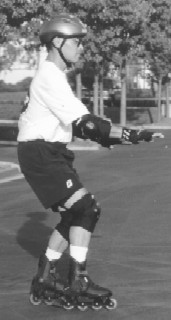One fine day while skating in farm
country, I found myself flying over a freshly plowed field of dirt clods
at high speed. The cow grate across the trail had been a big surprise
as I raced to catch up with another skater! That was my most memorable
test of hitting the rough in a Scissors Coast. Fortunately, my helmet
and an instinctive tuck and roll made this a non-event--except for
the embarrassment!
In real life, we learn that skating is not always about smooth, dry pavement
and uneventful outings. Whether it’s a rough spot on the trail or
street, that dreaded wood-slat bridge, or slippery conditions, your safety
(and fun!) depend your ability to handle unfriendly surfaces. Here are two
techniques that competent skaters use to survive such situations.
Scissors coast
 The
Scissors Coast is the best position to cross safely over a section of
rough stuff (brickwork, uneven, bumpy) or slippery conditions (oil, water,
wet leaves). It’s also a savior for unexpected bail-outs
like my cow grate experience.
The
Scissors Coast is the best position to cross safely over a section of
rough stuff (brickwork, uneven, bumpy) or slippery conditions (oil, water,
wet leaves). It’s also a savior for unexpected bail-outs
like my cow grate experience.
In the Scissors Coast, your wheels form
a longer, more stable platform, and you are very close to heel-braking
position, should you need it. After your front skate hits a surface that
slows it down, having most of your weight back on the second skate greatly
extends the amount of front-to-back “lurch” space,
as opposed to both of your front wheels suddenly slowing or stopping
at the same time.
To move quickly into a Scissors Coast, advance one
skate about a boot-length ahead of the other one, with skates no wider
than hip width. Your weight is ¾ on the back foot and ¼ on
the front foot, with both knees bent.
Use the Scissors Coast when you have enough momentum to fully cross problem
pavement. The faster you roll across, the less jostling you feel from a
bumpy surface and the easier it is to keep your balance. If it’s a
puddle and you have good enough balance, ride on one skate so you'll only
get one set of bearings wet.
For a high-speed emergency bail-out or if the surface looks especially
bad, get your hands up and in view, shift more weight to the rear skate,
and tighten your stomach muscles to stabilize your upper body on impact.
Don't forget Stride 1
As the building block for excellent
skating technique, Stride
1 is commonly known as the beginner’s
stride or Duck Walk. But using this "V" stance with weight on the heels
is also very useful in dicey situations. Stride 1 maximizes your stability
and control because your strokes and glides are shorter than you normally
skate, and your feet remain closer to your center of gravity.
Use Stride 1 if you get caught in the rain, need to get up a narrow uphill
or bridge, or when you don’t
have enough momentum to use the Scissors Coast. Making lots of short,
quick strokes allows you to keep moving forward without slipping or stalling.
You will also find Stride 1 useful
to get across a narrow or densely crowded section of trail.
Related reading